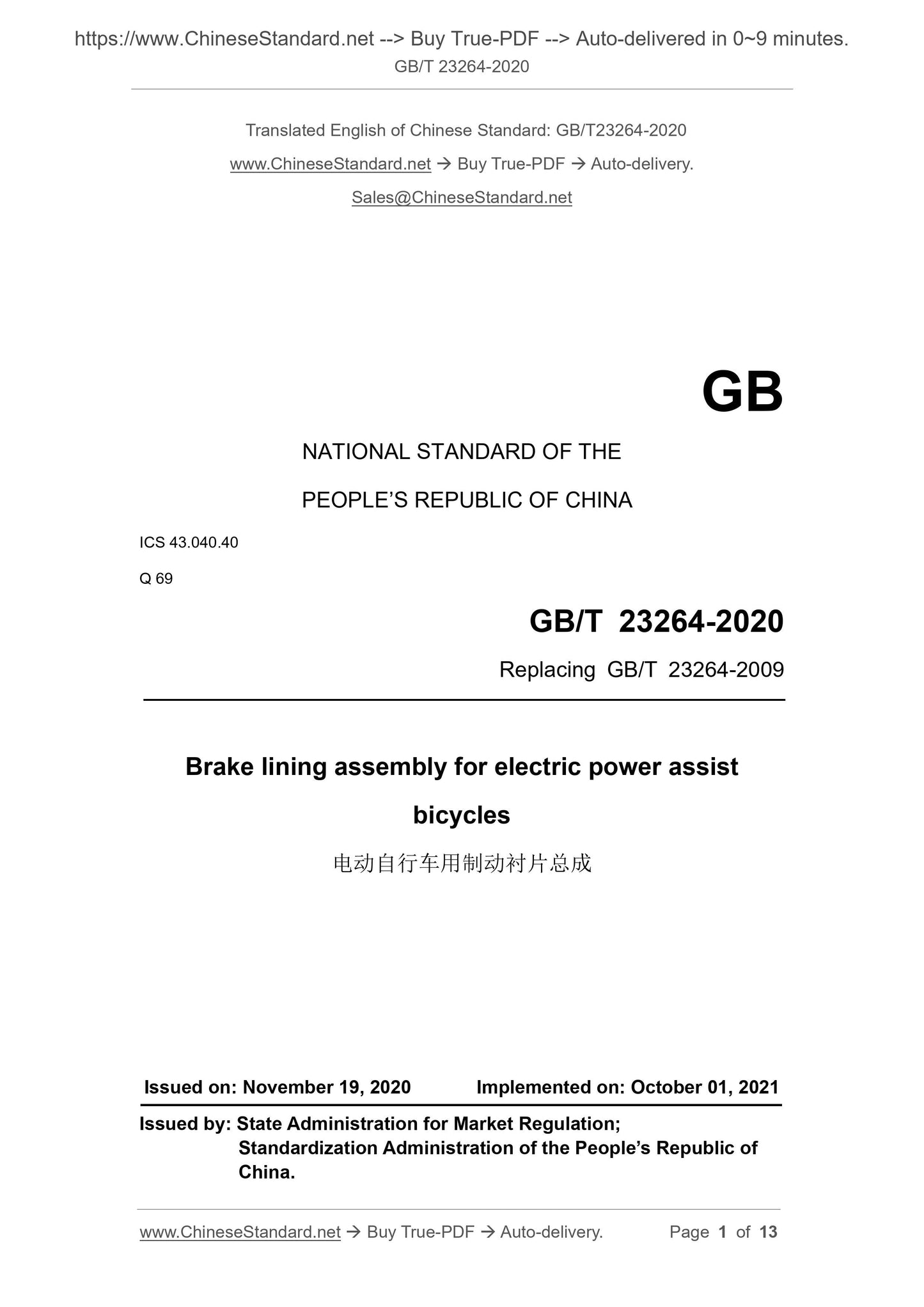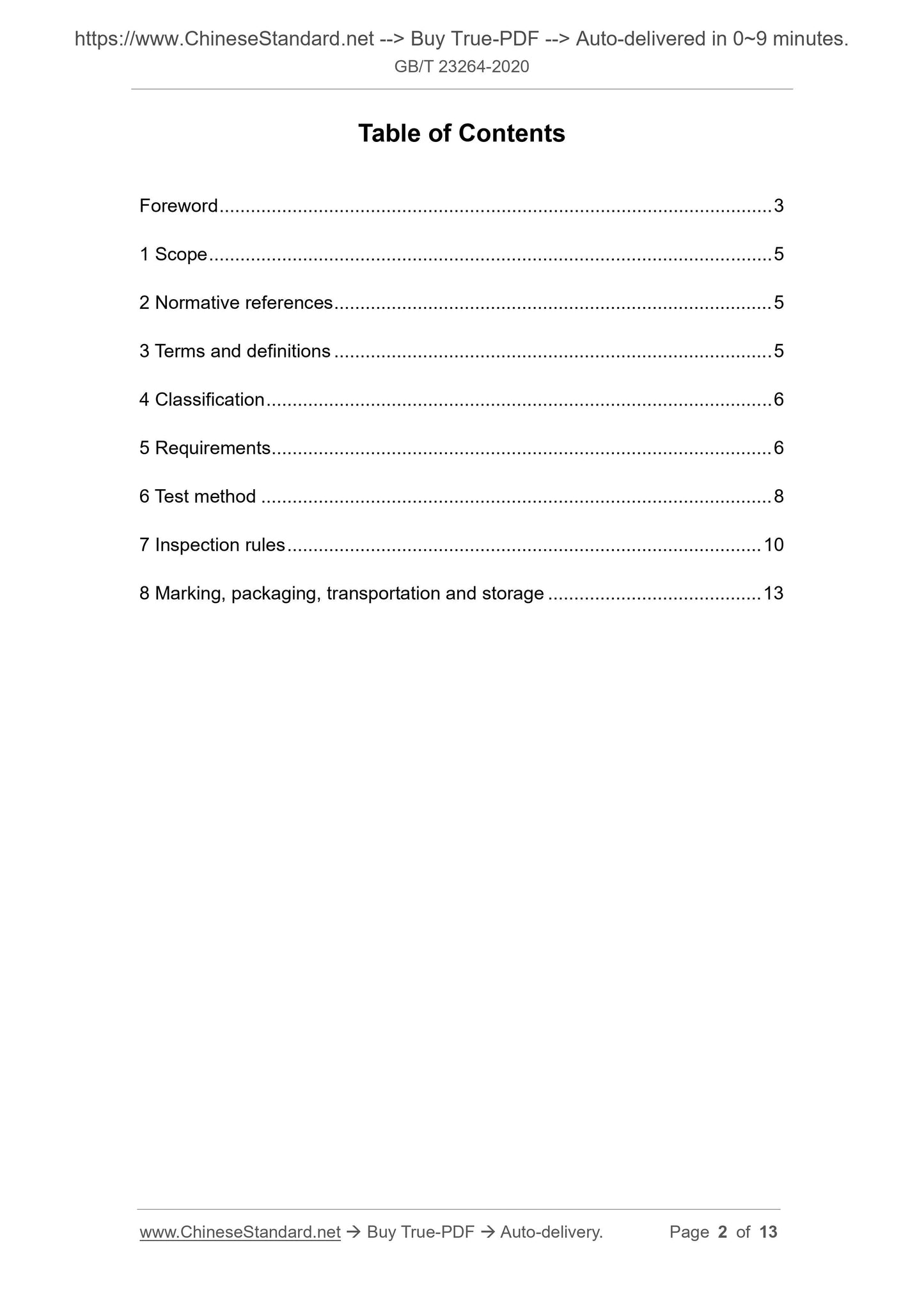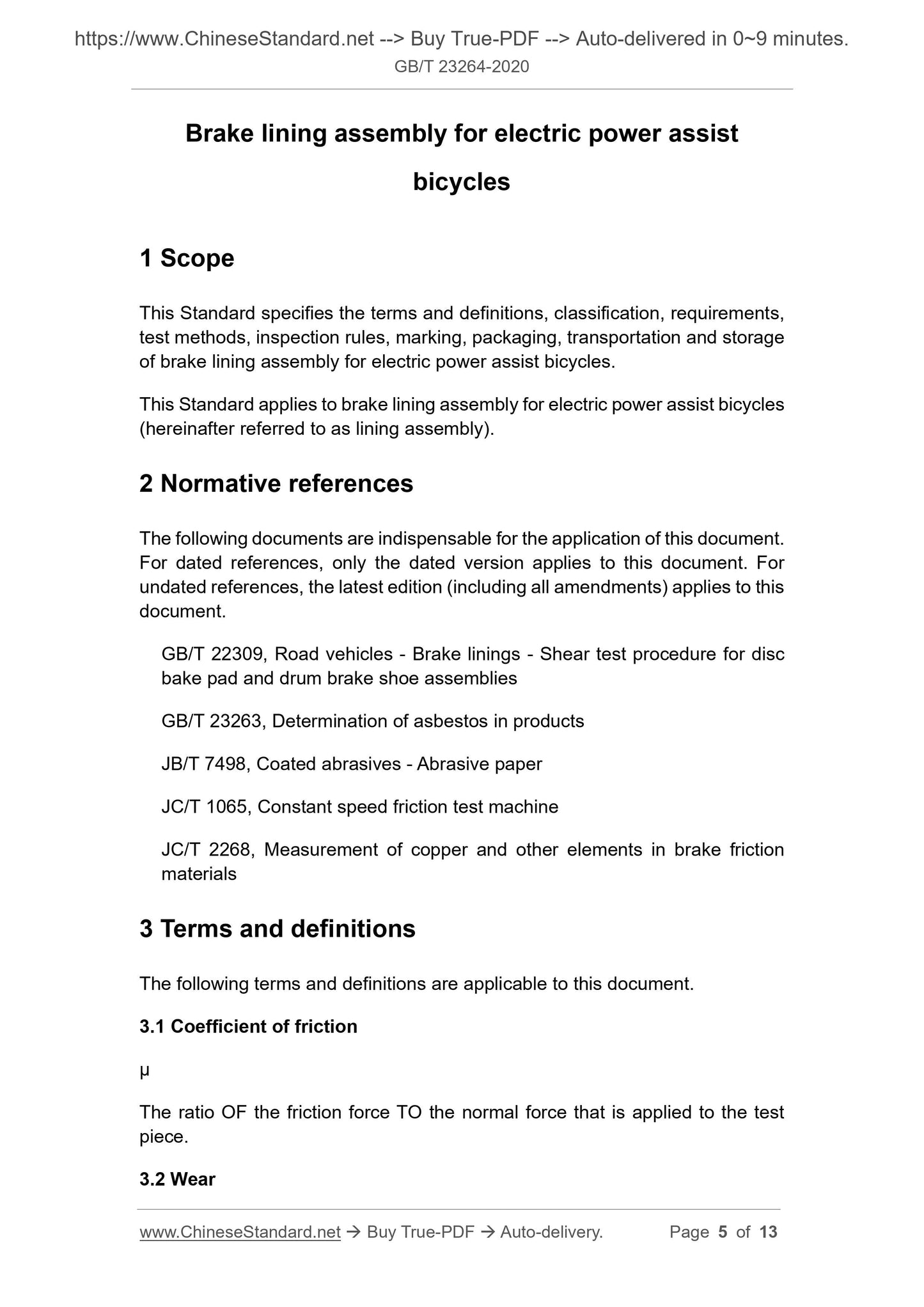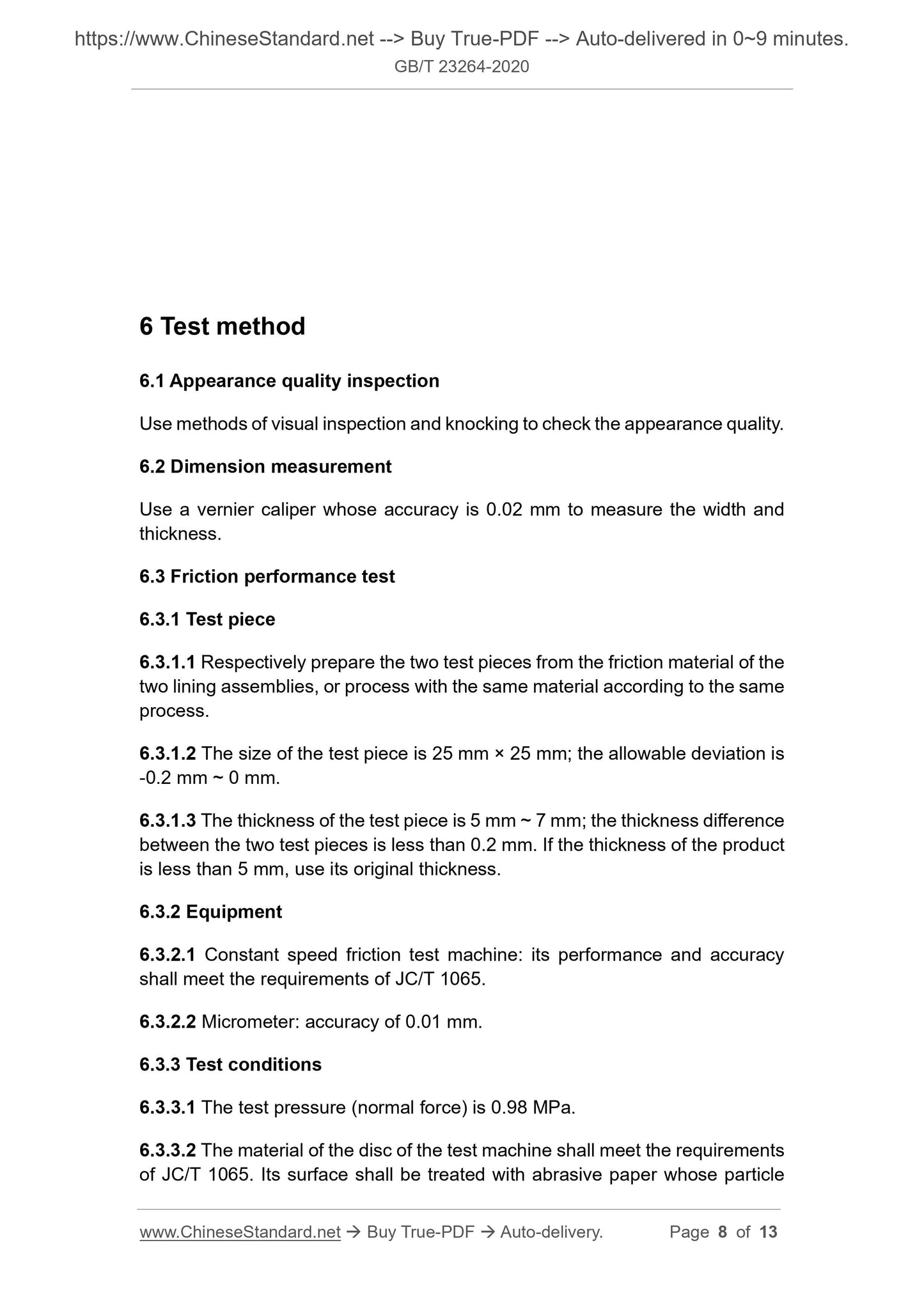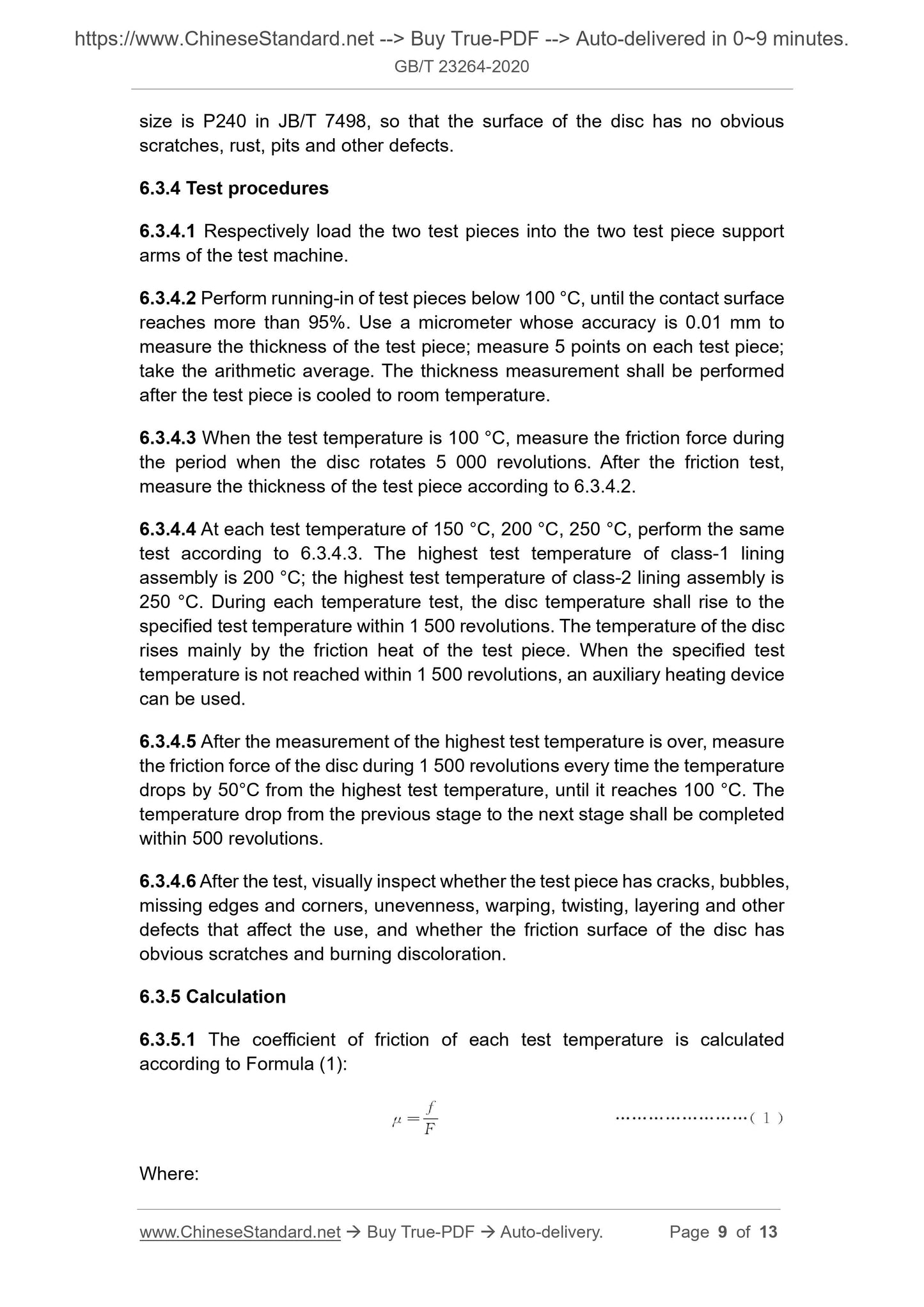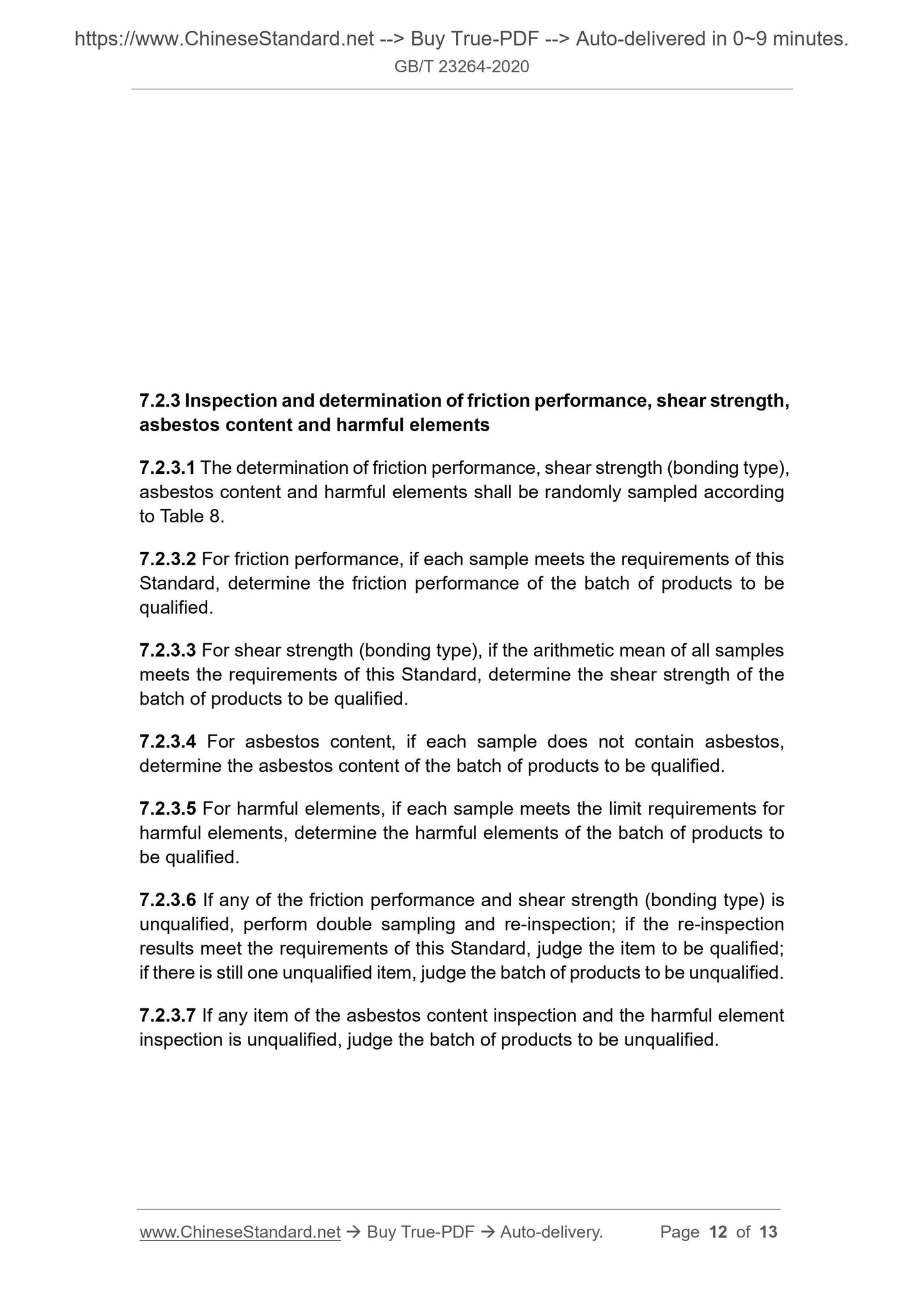1
/
of
6
www.ChineseStandard.us -- Field Test Asia Pte. Ltd.
GB/T 23264-2020 English PDF (GB/T23264-2020)
GB/T 23264-2020 English PDF (GB/T23264-2020)
Regular price
$155.00
Regular price
Sale price
$155.00
Unit price
/
per
Shipping calculated at checkout.
Couldn't load pickup availability
GB/T 23264-2020: Brake lining assembly for electric power assist bicycles
Delivery: 9 seconds. Download (& Email) true-PDF + Invoice.
Get Quotation: Click GB/T 23264-2020 (Self-service in 1-minute)
Historical versions (Master-website): GB/T 23264-2020
Preview True-PDF (Reload/Scroll-down if blank)
GB/T 23264-2020
GB
NATIONAL STANDARD OF THE
PEOPLE’S REPUBLIC OF CHINA
ICS 43.040.40
Q 69
Replacing GB/T 23264-2009
Brake lining assembly for electric power assist
bicycles
ISSUED ON: NOVEMBER 19, 2020
IMPLEMENTED ON: OCTOBER 01, 2021
Issued by: State Administration for Market Regulation;
Standardization Administration of the People’s Republic of
China.
Table of Contents
Foreword ... 3
1 Scope ... 5
2 Normative references ... 5
3 Terms and definitions ... 5
4 Classification ... 6
5 Requirements ... 6
6 Test method ... 8
7 Inspection rules ... 10
8 Marking, packaging, transportation and storage ... 13
Brake lining assembly for electric power assist
bicycles
1 Scope
This Standard specifies the terms and definitions, classification, requirements,
test methods, inspection rules, marking, packaging, transportation and storage
of brake lining assembly for electric power assist bicycles.
This Standard applies to brake lining assembly for electric power assist bicycles
(hereinafter referred to as lining assembly).
2 Normative references
The following documents are indispensable for the application of this document.
For dated references, only the dated version applies to this document. For
undated references, the latest edition (including all amendments) applies to this
document.
GB/T 22309, Road vehicles - Brake linings - Shear test procedure for disc
bake pad and drum brake shoe assemblies
GB/T 23263, Determination of asbestos in products
JB/T 7498, Coated abrasives - Abrasive paper
JC/T 1065, Constant speed friction test machine
JC/T 2268, Measurement of copper and other elements in brake friction
materials
3 Terms and definitions
The following terms and definitions are applicable to this document.
3.1 Coefficient of friction
The ratio OF the friction force TO the normal force that is applied to the test
piece.
3.2 Wear
6 Test method
6.1 Appearance quality inspection
Use methods of visual inspection and knocking to check the appearance quality.
6.2 Dimension measurement
Use a vernier caliper whose accuracy is 0.02 mm to measure the width and
thickness.
6.3 Friction performance test
6.3.1 Test piece
6.3.1.1 Respectively prepare the two test pieces from the friction material of the
two lining assemblies, or process with the same material according to the same
process.
6.3.1.2 The size of the test piece is 25 mm × 25 mm; the allowable deviation is
-0.2 mm ~ 0 mm.
6.3.1.3 The thickness of the test piece is 5 mm ~ 7 mm; the thickness difference
between the two test pieces is less than 0.2 mm. If the thickness of the product
is less than 5 mm, use its original thickness.
6.3.2 Equipment
6.3.2.1 Constant speed friction test machine: its performance and accuracy
shall meet the requirements of JC/T 1065.
6.3.2.2 Micrometer: accuracy of 0.01 mm.
6.3.3 Test conditions
6.3.3.1 The test pressure (normal force) is 0.98 MPa.
6.3.3.2 The material of the disc of the test machine shall meet the requirements
of JC/T 1065. Its surface shall be treated with abrasive paper whose particle
size is P240 in JB/T 7498, so that the surface of the disc has no obvious
scratches, rust, pits and other defects.
6.3.4 Test procedures
6.3.4.1 Respectively load the two test pieces into the two test piece support
arms of the test machine.
6.3.4.2 Perform running-in of test pieces below 100 °C, until the contact surface
reaches more than 95%. Use a micrometer whose accuracy is 0.01 mm to
measure the thickness of the test piece; measure 5 points on each test piece;
take the arithmetic average. The thickness measurement shall be performed
after the test piece is cooled to room temperature.
6.3.4.3 When the test temperature is 100 °C, measure the friction force during
the period when the disc rotates 5 000 revolutions. After the friction test,
measure the thickness of the test piece according to 6.3.4.2.
6.3.4.4 At each test temperature of 150 °C, 200 °C, 250 °C, perform the same
test according to 6.3.4.3. The highest test temperature of class-1 lining
assembly is 200 °C; the highest test temperature of class-2 lining assembly is
250 °C. During each temperature test, the disc temperature shall rise to the
specified test temperature within 1 500 revolutions. The temperature of the disc
rises mainly by the friction heat of the test piece. When the specified test
temperature is not reached within 1 500 revolutions, an auxiliary heating device
can be used.
6.3.4.5 After the measurement of the highest test temperature is over, measure
the friction force of the disc during 1 500 revolutions every time the temperature
drops by 50°C from the highest test temperature, until it reaches 100 °C. The
temperature drop from the previous stage to the next stage shall be completed
within 500 revolutions.
6.3.4.6 After the test, visually inspect whether the test piece has cracks, bubbles,
missing edges and corners, unevenness, warping, twisting, layering and other
defects that affect the use, and whether the friction surface of the disc has
obvious scratches and burning discoloration.
6.3.5 Calculation
6.3.5.1 The coefficient of friction of each test temperature is calculated
according to Formula (1):
Where:
7.2.3 Inspection and determination of friction performance, shear strength,
asbestos content and harmful elements
7.2.3.1 The determination of friction performance, shear strength (bonding type),
asbestos content and harmful elements shall be randomly sampled according
to Table 8.
7.2.3.2 For friction performance, if each sample meets the requirements of this
Standard, determine the friction performance of the batch of products to be
qualified.
7.2.3.3 For shear strength (bonding type), if the arithmetic mean of all samples
meets the requirements of this Standard, determine the shear strength of the
batch of products to be qualified.
7.2.3.4 For asbestos content, if each sample does not contain asbestos,
determine the asbestos content of the batch of products to be qualified.
7.2.3.5 For harmful elements, if each sample meets the limit requirements for
harmful elements, determine the harmful elements of the batch of products to
be qualified.
7.2.3.6 If any of the friction performance and shear strength (bonding type) is
unqualified, perform double sampling and re-inspection; if the re-inspection
results meet the requirements of this Standard, judge the item to be qualified;
if there is still one unqualified item, judge the batch of products to be unqualified.
7.2.3.7 If any item of the asbestos content inspection and the harmful element
inspection is unqualified, judge the batch of products to be unqualified.
GB/T 23264-2020
GB
NATIONAL STANDARD OF THE
PEOPLE’S REPUBLIC OF CHINA
ICS 43.040.40
Q 69
Replacing GB/T 23264-2009
Brake lining assembly for electric power assist
bicycles
ISSUED ON: NOVEMBER 19, 2020
IMPLEMENTED ON: OCTOBER 01, 2021
Issued by: State Administration for Market Regulation;
Standardization Administration of the People’s Republic of
China.
Table of Contents
Foreword ... 3
1 Scope ... 5
2 Normative references ... 5
3 Terms and definitions ... 5
4 Classification ... 6
5 Requirements ... 6
6 Test method ... 8
7 Inspection rules ... 10
8 Marking, packaging, transportation and storage ... 13
Brake lining assembly for electric power assist
bicycles
1 Scope
This Standard specifies the terms and definitions, classification, requirements,
test methods, inspection rules, marking, packaging, transportation and storage
of brake lining assembly for electric power assist bicycles.
This Standard applies to brake lining assembly for electric power assist bicycles
(hereinafter referred to as lining assembly).
2 Normative references
The following documents are indispensable for the application of this document.
For dated references, only the dated version applies to this document. For
undated references, the latest edition (including all amendments) applies to this
document.
GB/T 22309, Road vehicles - Brake linings - Shear test procedure for disc
bake pad and drum brake shoe assemblies
GB/T 23263, Determination of asbestos in products
JB/T 7498, Coated abrasives - Abrasive paper
JC/T 1065, Constant speed friction test machine
JC/T 2268, Measurement of copper and other elements in brake friction
materials
3 Terms and definitions
The following terms and definitions are applicable to this document.
3.1 Coefficient of friction
The ratio OF the friction force TO the normal force that is applied to the test
piece.
3.2 Wear
6 Test method
6.1 Appearance quality inspection
Use methods of visual inspection and knocking to check the appearance quality.
6.2 Dimension measurement
Use a vernier caliper whose accuracy is 0.02 mm to measure the width and
thickness.
6.3 Friction performance test
6.3.1 Test piece
6.3.1.1 Respectively prepare the two test pieces from the friction material of the
two lining assemblies, or process with the same material according to the same
process.
6.3.1.2 The size of the test piece is 25 mm × 25 mm; the allowable deviation is
-0.2 mm ~ 0 mm.
6.3.1.3 The thickness of the test piece is 5 mm ~ 7 mm; the thickness difference
between the two test pieces is less than 0.2 mm. If the thickness of the product
is less than 5 mm, use its original thickness.
6.3.2 Equipment
6.3.2.1 Constant speed friction test machine: its performance and accuracy
shall meet the requirements of JC/T 1065.
6.3.2.2 Micrometer: accuracy of 0.01 mm.
6.3.3 Test conditions
6.3.3.1 The test pressure (normal force) is 0.98 MPa.
6.3.3.2 The material of the disc of the test machine shall meet the requirements
of JC/T 1065. Its surface shall be treated with abrasive paper whose particle
size is P240 in JB/T 7498, so that the surface of the disc has no obvious
scratches, rust, pits and other defects.
6.3.4 Test procedures
6.3.4.1 Respectively load the two test pieces into the two test piece support
arms of the test machine.
6.3.4.2 Perform running-in of test pieces below 100 °C, until the contact surface
reaches more than 95%. Use a micrometer whose accuracy is 0.01 mm to
measure the thickness of the test piece; measure 5 points on each test piece;
take the arithmetic average. The thickness measurement shall be performed
after the test piece is cooled to room temperature.
6.3.4.3 When the test temperature is 100 °C, measure the friction force during
the period when the disc rotates 5 000 revolutions. After the friction test,
measure the thickness of the test piece according to 6.3.4.2.
6.3.4.4 At each test temperature of 150 °C, 200 °C, 250 °C, perform the same
test according to 6.3.4.3. The highest test temperature of class-1 lining
assembly is 200 °C; the highest test temperature of class-2 lining assembly is
250 °C. During each temperature test, the disc temperature shall rise to the
specified test temperature within 1 500 revolutions. The temperature of the disc
rises mainly by the friction heat of the test piece. When the specified test
temperature is not reached within 1 500 revolutions, an auxiliary heating device
can be used.
6.3.4.5 After the measurement of the highest test temperature is over, measure
the friction force of the disc during 1 500 revolutions every time the temperature
drops by 50°C from the highest test temperature, until it reaches 100 °C. The
temperature drop from the previous stage to the next stage shall be completed
within 500 revolutions.
6.3.4.6 After the test, visually inspect whether the test piece has cracks, bubbles,
missing edges and corners, unevenness, warping, twisting, layering and other
defects that affect the use, and whether the friction surface of the disc has
obvious scratches and burning discoloration.
6.3.5 Calculation
6.3.5.1 The coefficient of friction of each test temperature is calculated
according to Formula (1):
Where:
7.2.3 Inspection and determination of friction performance, shear strength,
asbestos content and harmful elements
7.2.3.1 The determination of friction performance, shear strength (bonding type),
asbestos content and harmful elements shall be randomly sampled according
to Table 8.
7.2.3.2 For friction performance, if each sample meets the requirements of this
Standard, determine the friction performance of the batch of products to be
qualified.
7.2.3.3 For shear strength (bonding type), if the arithmetic mean of all samples
meets the requirements of this Standard, determine the shear strength of the
batch of products to be qualified.
7.2.3.4 For asbestos content, if each sample does not contain asbestos,
determine the asbestos content of the batch of products to be qualified.
7.2.3.5 For harmful elements, if each sample meets the limit requirements for
harmful elements, determine the harmful elements of the batch of products to
be qualified.
7.2.3.6 If any of the friction performance and shear strength (bonding type) is
unqualified, perform double sampling and re-inspection; if the re-inspection
results meet the requirements of this Standard, judge the item to be qualified;
if there is still one unqualified item, judge the batch of products to be unqualified.
7.2.3.7 If any item of the asbestos content inspection and the harmful element
inspection is unqualified, judge the batch of products to be unqualified.
Delivery: 9 seconds. Download (& Email) true-PDF + Invoice.
Get Quotation: Click GB/T 23264-2020 (Self-service in 1-minute)
Historical versions (Master-website): GB/T 23264-2020
Preview True-PDF (Reload/Scroll-down if blank)
GB/T 23264-2020
GB
NATIONAL STANDARD OF THE
PEOPLE’S REPUBLIC OF CHINA
ICS 43.040.40
Q 69
Replacing GB/T 23264-2009
Brake lining assembly for electric power assist
bicycles
ISSUED ON: NOVEMBER 19, 2020
IMPLEMENTED ON: OCTOBER 01, 2021
Issued by: State Administration for Market Regulation;
Standardization Administration of the People’s Republic of
China.
Table of Contents
Foreword ... 3
1 Scope ... 5
2 Normative references ... 5
3 Terms and definitions ... 5
4 Classification ... 6
5 Requirements ... 6
6 Test method ... 8
7 Inspection rules ... 10
8 Marking, packaging, transportation and storage ... 13
Brake lining assembly for electric power assist
bicycles
1 Scope
This Standard specifies the terms and definitions, classification, requirements,
test methods, inspection rules, marking, packaging, transportation and storage
of brake lining assembly for electric power assist bicycles.
This Standard applies to brake lining assembly for electric power assist bicycles
(hereinafter referred to as lining assembly).
2 Normative references
The following documents are indispensable for the application of this document.
For dated references, only the dated version applies to this document. For
undated references, the latest edition (including all amendments) applies to this
document.
GB/T 22309, Road vehicles - Brake linings - Shear test procedure for disc
bake pad and drum brake shoe assemblies
GB/T 23263, Determination of asbestos in products
JB/T 7498, Coated abrasives - Abrasive paper
JC/T 1065, Constant speed friction test machine
JC/T 2268, Measurement of copper and other elements in brake friction
materials
3 Terms and definitions
The following terms and definitions are applicable to this document.
3.1 Coefficient of friction
The ratio OF the friction force TO the normal force that is applied to the test
piece.
3.2 Wear
6 Test method
6.1 Appearance quality inspection
Use methods of visual inspection and knocking to check the appearance quality.
6.2 Dimension measurement
Use a vernier caliper whose accuracy is 0.02 mm to measure the width and
thickness.
6.3 Friction performance test
6.3.1 Test piece
6.3.1.1 Respectively prepare the two test pieces from the friction material of the
two lining assemblies, or process with the same material according to the same
process.
6.3.1.2 The size of the test piece is 25 mm × 25 mm; the allowable deviation is
-0.2 mm ~ 0 mm.
6.3.1.3 The thickness of the test piece is 5 mm ~ 7 mm; the thickness difference
between the two test pieces is less than 0.2 mm. If the thickness of the product
is less than 5 mm, use its original thickness.
6.3.2 Equipment
6.3.2.1 Constant speed friction test machine: its performance and accuracy
shall meet the requirements of JC/T 1065.
6.3.2.2 Micrometer: accuracy of 0.01 mm.
6.3.3 Test conditions
6.3.3.1 The test pressure (normal force) is 0.98 MPa.
6.3.3.2 The material of the disc of the test machine shall meet the requirements
of JC/T 1065. Its surface shall be treated with abrasive paper whose particle
size is P240 in JB/T 7498, so that the surface of the disc has no obvious
scratches, rust, pits and other defects.
6.3.4 Test procedures
6.3.4.1 Respectively load the two test pieces into the two test piece support
arms of the test machine.
6.3.4.2 Perform running-in of test pieces below 100 °C, until the contact surface
reaches more than 95%. Use a micrometer whose accuracy is 0.01 mm to
measure the thickness of the test piece; measure 5 points on each test piece;
take the arithmetic average. The thickness measurement shall be performed
after the test piece is cooled to room temperature.
6.3.4.3 When the test temperature is 100 °C, measure the friction force during
the period when the disc rotates 5 000 revolutions. After the friction test,
measure the thickness of the test piece according to 6.3.4.2.
6.3.4.4 At each test temperature of 150 °C, 200 °C, 250 °C, perform the same
test according to 6.3.4.3. The highest test temperature of class-1 lining
assembly is 200 °C; the highest test temperature of class-2 lining assembly is
250 °C. During each temperature test, the disc temperature shall rise to the
specified test temperature within 1 500 revolutions. The temperature of the disc
rises mainly by the friction heat of the test piece. When the specified test
temperature is not reached within 1 500 revolutions, an auxiliary heating device
can be used.
6.3.4.5 After the measurement of the highest test temperature is over, measure
the friction force of the disc during 1 500 revolutions every time the temperature
drops by 50°C from the highest test temperature, until it reaches 100 °C. The
temperature drop from the previous stage to the next stage shall be completed
within 500 revolutions.
6.3.4.6 After the test, visually inspect whether the test piece has cracks, bubbles,
missing edges and corners, unevenness, warping, twisting, layering and other
defects that affect the use, and whether the friction surface of the disc has
obvious scratches and burning discoloration.
6.3.5 Calculation
6.3.5.1 The coefficient of friction of each test temperature is calculated
according to Formula (1):
Where:
7.2.3 Inspection and determination of friction performance, shear strength,
asbestos content and harmful elements
7.2.3.1 The determination of friction performance, shear strength (bonding type),
asbestos content and harmful elements shall be randomly sampled according
to Table 8.
7.2.3.2 For friction performance, if each sample meets the requirements of this
Standard, determine the friction performance of the batch of products to be
qualified.
7.2.3.3 For shear strength (bonding type), if the arithmetic mean of all samples
meets the requirements of this Standard, determine the shear strength of the
batch of products to be qualified.
7.2.3.4 For asbestos content, if each sample does not contain asbestos,
determine the asbestos content of the batch of products to be qualified.
7.2.3.5 For harmful elements, if each sample meets the limit requirements for
harmful elements, determine the harmful elements of the batch of products to
be qualified.
7.2.3.6 If any of the friction performance and shear strength (bonding type) is
unqualified, perform double sampling and re-inspection; if the re-inspection
results meet the requirements of this Standard, judge the item to be qualified;
if there is still one unqualified item, judge the batch of products to be unqualified.
7.2.3.7 If any item of the asbestos content inspection and the harmful element
inspection is unqualified, judge the batch of products to be unqualified.
GB/T 23264-2020
GB
NATIONAL STANDARD OF THE
PEOPLE’S REPUBLIC OF CHINA
ICS 43.040.40
Q 69
Replacing GB/T 23264-2009
Brake lining assembly for electric power assist
bicycles
ISSUED ON: NOVEMBER 19, 2020
IMPLEMENTED ON: OCTOBER 01, 2021
Issued by: State Administration for Market Regulation;
Standardization Administration of the People’s Republic of
China.
Table of Contents
Foreword ... 3
1 Scope ... 5
2 Normative references ... 5
3 Terms and definitions ... 5
4 Classification ... 6
5 Requirements ... 6
6 Test method ... 8
7 Inspection rules ... 10
8 Marking, packaging, transportation and storage ... 13
Brake lining assembly for electric power assist
bicycles
1 Scope
This Standard specifies the terms and definitions, classification, requirements,
test methods, inspection rules, marking, packaging, transportation and storage
of brake lining assembly for electric power assist bicycles.
This Standard applies to brake lining assembly for electric power assist bicycles
(hereinafter referred to as lining assembly).
2 Normative references
The following documents are indispensable for the application of this document.
For dated references, only the dated version applies to this document. For
undated references, the latest edition (including all amendments) applies to this
document.
GB/T 22309, Road vehicles - Brake linings - Shear test procedure for disc
bake pad and drum brake shoe assemblies
GB/T 23263, Determination of asbestos in products
JB/T 7498, Coated abrasives - Abrasive paper
JC/T 1065, Constant speed friction test machine
JC/T 2268, Measurement of copper and other elements in brake friction
materials
3 Terms and definitions
The following terms and definitions are applicable to this document.
3.1 Coefficient of friction
The ratio OF the friction force TO the normal force that is applied to the test
piece.
3.2 Wear
6 Test method
6.1 Appearance quality inspection
Use methods of visual inspection and knocking to check the appearance quality.
6.2 Dimension measurement
Use a vernier caliper whose accuracy is 0.02 mm to measure the width and
thickness.
6.3 Friction performance test
6.3.1 Test piece
6.3.1.1 Respectively prepare the two test pieces from the friction material of the
two lining assemblies, or process with the same material according to the same
process.
6.3.1.2 The size of the test piece is 25 mm × 25 mm; the allowable deviation is
-0.2 mm ~ 0 mm.
6.3.1.3 The thickness of the test piece is 5 mm ~ 7 mm; the thickness difference
between the two test pieces is less than 0.2 mm. If the thickness of the product
is less than 5 mm, use its original thickness.
6.3.2 Equipment
6.3.2.1 Constant speed friction test machine: its performance and accuracy
shall meet the requirements of JC/T 1065.
6.3.2.2 Micrometer: accuracy of 0.01 mm.
6.3.3 Test conditions
6.3.3.1 The test pressure (normal force) is 0.98 MPa.
6.3.3.2 The material of the disc of the test machine shall meet the requirements
of JC/T 1065. Its surface shall be treated with abrasive paper whose particle
size is P240 in JB/T 7498, so that the surface of the disc has no obvious
scratches, rust, pits and other defects.
6.3.4 Test procedures
6.3.4.1 Respectively load the two test pieces into the two test piece support
arms of the test machine.
6.3.4.2 Perform running-in of test pieces below 100 °C, until the contact surface
reaches more than 95%. Use a micrometer whose accuracy is 0.01 mm to
measure the thickness of the test piece; measure 5 points on each test piece;
take the arithmetic average. The thickness measurement shall be performed
after the test piece is cooled to room temperature.
6.3.4.3 When the test temperature is 100 °C, measure the friction force during
the period when the disc rotates 5 000 revolutions. After the friction test,
measure the thickness of the test piece according to 6.3.4.2.
6.3.4.4 At each test temperature of 150 °C, 200 °C, 250 °C, perform the same
test according to 6.3.4.3. The highest test temperature of class-1 lining
assembly is 200 °C; the highest test temperature of class-2 lining assembly is
250 °C. During each temperature test, the disc temperature shall rise to the
specified test temperature within 1 500 revolutions. The temperature of the disc
rises mainly by the friction heat of the test piece. When the specified test
temperature is not reached within 1 500 revolutions, an auxiliary heating device
can be used.
6.3.4.5 After the measurement of the highest test temperature is over, measure
the friction force of the disc during 1 500 revolutions every time the temperature
drops by 50°C from the highest test temperature, until it reaches 100 °C. The
temperature drop from the previous stage to the next stage shall be completed
within 500 revolutions.
6.3.4.6 After the test, visually inspect whether the test piece has cracks, bubbles,
missing edges and corners, unevenness, warping, twisting, layering and other
defects that affect the use, and whether the friction surface of the disc has
obvious scratches and burning discoloration.
6.3.5 Calculation
6.3.5.1 The coefficient of friction of each test temperature is calculated
according to Formula (1):
Where:
7.2.3 Inspection and determination of friction performance, shear strength,
asbestos content and harmful elements
7.2.3.1 The determination of friction performance, shear strength (bonding type),
asbestos content and harmful elements shall be randomly sampled according
to Table 8.
7.2.3.2 For friction performance, if each sample meets the requirements of this
Standard, determine the friction performance of the batch of products to be
qualified.
7.2.3.3 For shear strength (bonding type), if the arithmetic mean of all samples
meets the requirements of this Standard, determine the shear strength of the
batch of products to be qualified.
7.2.3.4 For asbestos content, if each sample does not contain asbestos,
determine the asbestos content of the batch of products to be qualified.
7.2.3.5 For harmful elements, if each sample meets the limit requirements for
harmful elements, determine the harmful elements of the batch of products to
be qualified.
7.2.3.6 If any of the friction performance and shear strength (bonding type) is
unqualified, perform double sampling and re-inspection; if the re-inspection
results meet the requirements of this Standard, judge the item to be qualified;
if there is still one unqualified item, judge the batch of products to be unqualified.
7.2.3.7 If any item of the asbestos content inspection and the harmful element
inspection is unqualified, judge the batch of products to be unqualified.
Share
